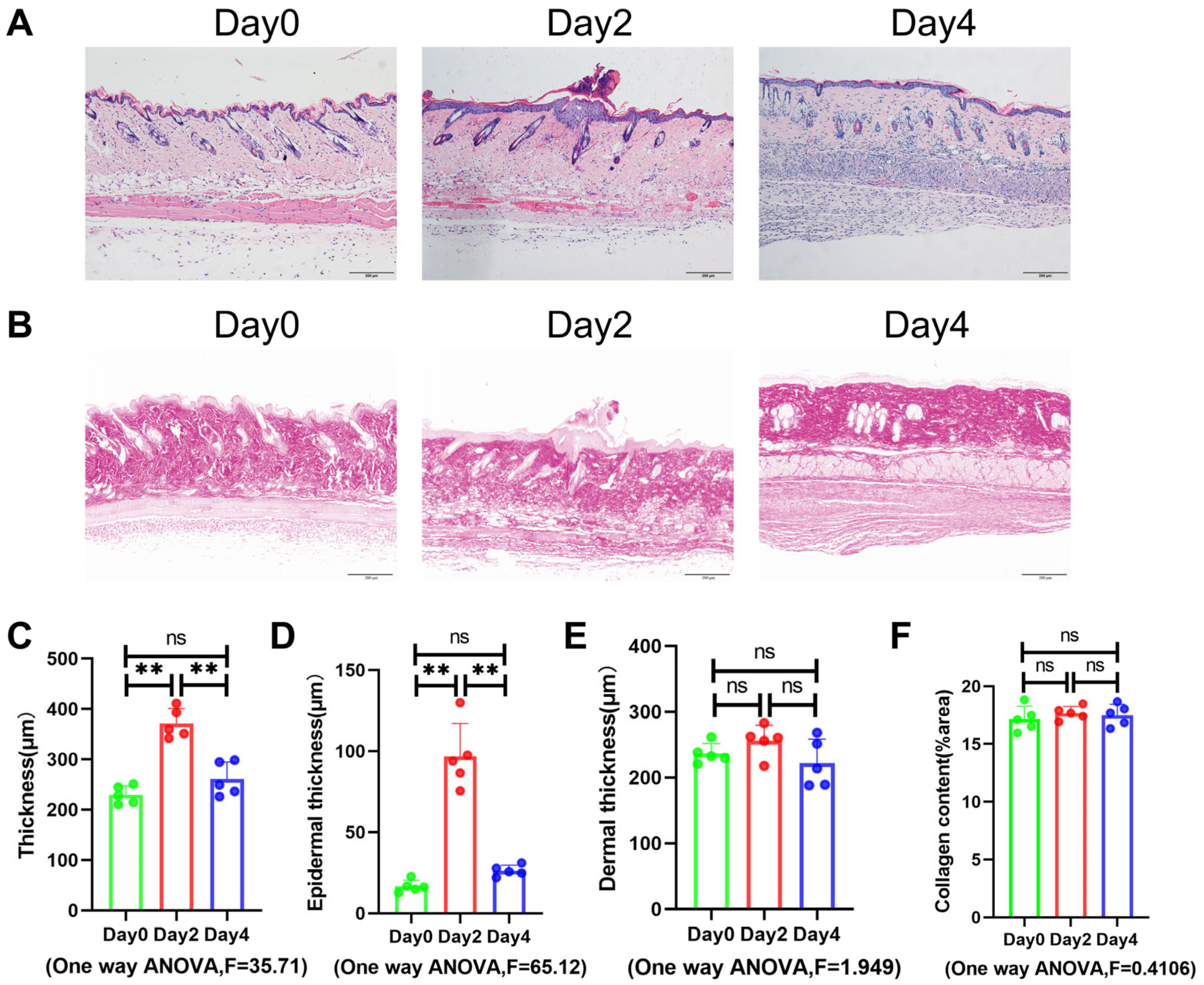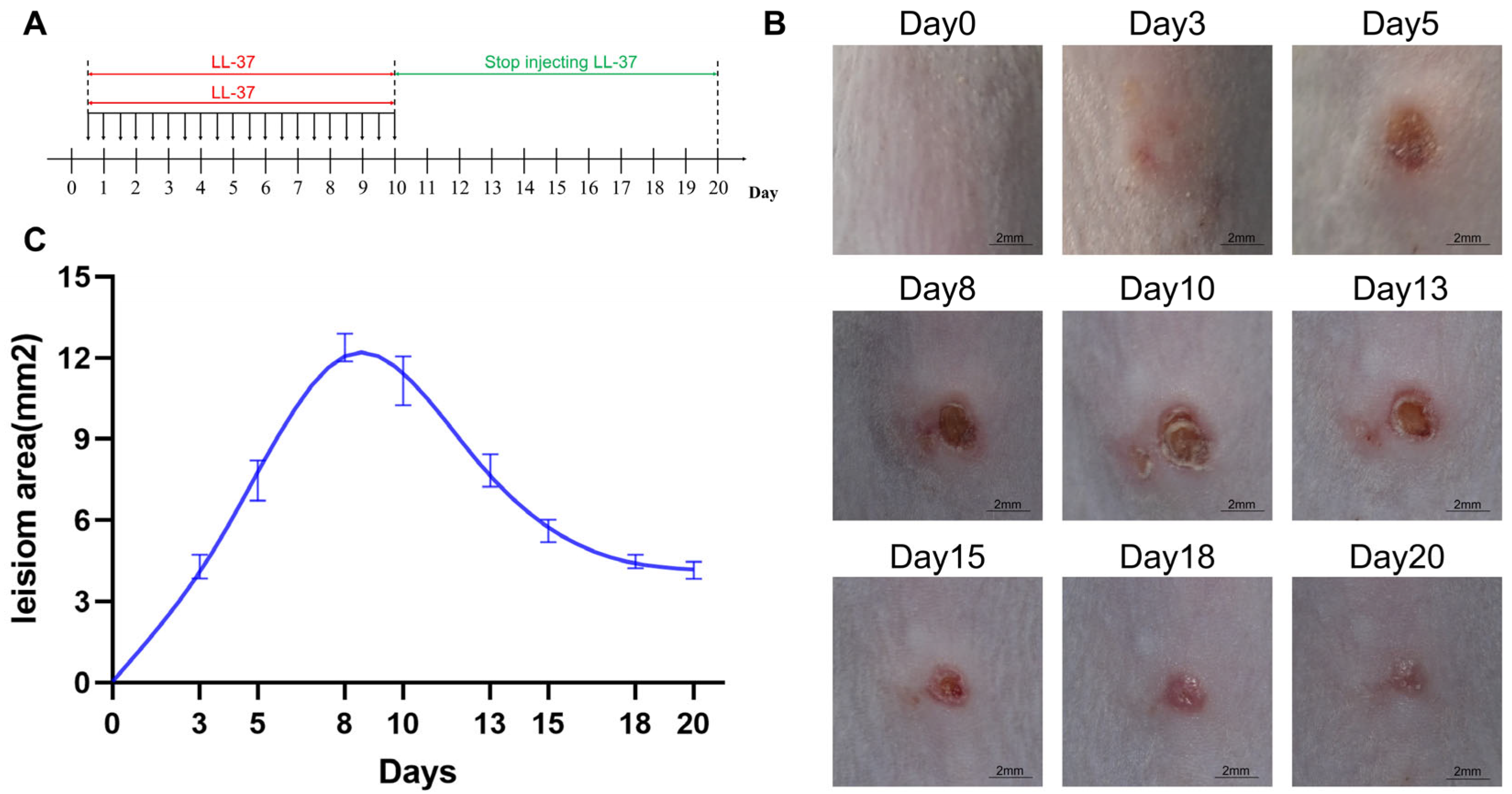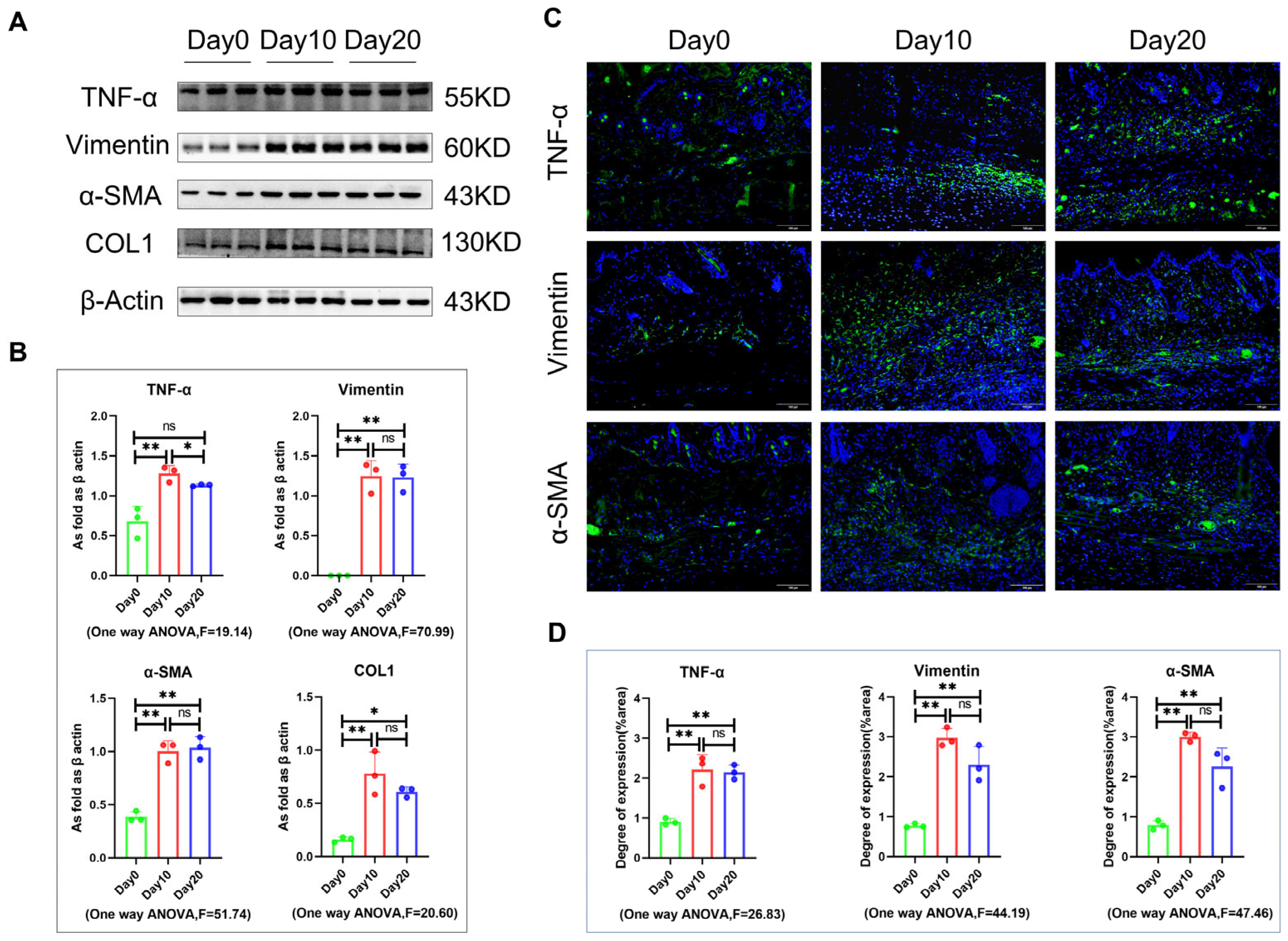Long-Term Administration of LL-37 Can Induce Irreversible Rosacea-like Lesion
Abstract
1. Introduction
2. Materials and Methods
2.1. Animal Experiments
2.2. Histological Examination of Skin Tissue
2.3. Immunofluorescence Staining
2.4. Western Blot
2.5. Statistical Analysis
3. Results
3.1. The Degree of Rosacea-like Skin Lesions Induced by Long-Term LL-37 Administration Was More Severe Than Those Induced by Short-Term Administration
3.2. Rosacea-like Lesions Induced by Short-Term LL-37 Administration Were Able to Recover Spontaneously
3.3. Rosacea-like Lesions Induced by Long-Term LL-37 Administration Did Not Fully Recover on Their Own
4. Discussion
Author Contributions
Funding
Institutional Review Board Statement
Informed Consent Statement
Data Availability Statement
Conflicts of Interest
References
- Van Zuuren, E.J.; Arents, B.W.M.; van der Linden, M.M.D.; Vermeulen, S.; Fedorowicz, Z.; Tan, J. Rosacea: New Concepts in Classification and Treatment. Am. J. Clin. Dermatol. 2021, 22, 457–465. [Google Scholar] [CrossRef]
- Buddenkotte, J.; Steinhoff, M. Recent advances in understanding and managing rosacea. F1000Research 2018, 7, 1885. [Google Scholar] [CrossRef] [PubMed]
- Kang, C.N.; Shah, M.; Tan, J. Rosacea: An Update in Diagnosis, Classification and Management. Skin Ther. Lett. 2021, 26, 1–8. [Google Scholar]
- Marson, J.W.; Baldwin, H.E. Rosacea: A wholistic review and update from pathogenesis to diagnosis and therapy. Int. J. Dermatol. 2020, 59, e175–e182. [Google Scholar] [CrossRef]
- Thiboutot, D.; Anderson, R.; Cook-Bolden, F.; Draelos, Z.; Gallo, R.L.; Granstein, R.D.; Kang, S.; Macsai, M.; Gold, L.S.; Tan, J. Standard management options for rosacea: The 2019 update by the National Rosacea Society Expert Committee. J. Am. Acad. Dermatol. 2020, 82, 1501–1510. [Google Scholar] [CrossRef]
- Rainer, B.M.; Kang, S.; Chien, A.L. Rosacea: Epidemiology, pathogenesis, and treatment. Derm. -Endocrinol. 2017, 9, e1361574. [Google Scholar] [CrossRef] [PubMed]
- Alexis, A.F.; Callender, V.D.; Baldwin, H.E.; Desai, S.R.; Rendon, M.I.; Taylor, S.C. Global epidemiology and clinical spectrum of rosacea, highlighting skin of color: Review and clinical practice experience. J. Am. Acad. Dermatol. 2019, 80, 1722–1729.e7. [Google Scholar] [CrossRef] [PubMed]
- Moustafa, F.; Lewallen, R.S.; Feldman, S.R. The psychological impact of rosacea and the influence of current management options. J. Am. Acad. Dermatol. 2014, 71, 973–980. [Google Scholar] [CrossRef]
- Fry, D.E. Antimicrobial Peptides. Surg. Infect. 2018, 19, 804–811. [Google Scholar] [CrossRef]
- Bin Hafeez, A.; Jiang, X.; Bergen, P.J.; Zhu, Y. Antimicrobial Peptides: An Update on Classifications and Databases. Int. J. Mol. Sci. 2021, 22, 11691. [Google Scholar] [CrossRef]
- Li, L.; Peng, Y.; Yuan, Q.; Sun, J.; Zhuang, A.; Bi, X. Cathelicidin LL37 Promotes Osteogenic Differentiation in vitro and Bone Regeneration in vivo. Front. Bioeng. Biotechnol. 2021, 9, 638494. [Google Scholar] [CrossRef]
- Ramos, R.; Silva, J.P.; Rodrigues, A.C.; Costa, R.; Guardão, L.; Schmitt, F.; Soares, R.; Vilanova, M.; Domingues, L.; Gama, M. Wound healing activity of the human antimicrobial peptide LL37. Peptides 2011, 32, 1469–1476. [Google Scholar] [CrossRef]
- Xhindoli, D.; Pacor, S.; Guida, F.; Antcheva, N.; Tossi, A. Native oligomerization determines the mode of action and biological activities of human cathelicidin LL-37. Biochem. J. 2014, 457, 263–275. [Google Scholar] [CrossRef]
- Bucki, R.; Leszczyńska, K.; Namiot, A.; Sokołowski, W. Cathelicidin LL-37: A multitask antimicrobial peptide. Arch. Immunol. Ther. Exp. 2010, 58, 15–25. [Google Scholar] [CrossRef] [PubMed]
- Moreno-Angarita, A.; Aragón, C.C.; Tobón, G.J. Cathelicidin LL-37: A new important molecule in the pathophysiology of systemic lupus erythematosus. J. Transl. Autoimmun. 2020, 3, 100029. [Google Scholar] [CrossRef]
- Macleod, T.; Ward, J.; Alase, A.A.; Bridgewood, C.; Wittmann, M.; Stonehouse, N.J. Antimicrobial Peptide LL-37 Facilitates Intracellular Uptake of RNA Aptamer Apt 21-2 Without Inducing an Inflammatory or Interferon Response. Front. Immunol. 2019, 10, 857. [Google Scholar] [CrossRef] [PubMed]
- Luo, Y.; Song, Y. Mechanism of Antimicrobial Peptides: Antimicrobial, Anti-Inflammatory and Antibiofilm Activities. Int. J. Mol. Sci. 2021, 22, 11401. [Google Scholar] [CrossRef]
- Yoon, S.-H.; Hwang, I.; Lee, E.; Cho, H.-J.; Ryu, J.H.; Kim, T.-G.; Yu, J.-W. Antimicrobial Peptide LL-37 Drives Rosacea-Like Skin Inflammation in an NLRP3-Dependent Manner. J. Investig. Dermatol. 2021, 141, 2885–2894.e5. [Google Scholar] [CrossRef] [PubMed]
- Yamasaki, K.; Di Nardo, A.; Bardan, A.; Murakami, M.; Ohtake, T.; Coda, A.; Dorschner, R.A.; Bonnart, C.; Descargues, P.; Hovnanian, A.; et al. Increased serine protease activity and cathelicidin promotes skin inflammation in rosacea. Nat. Med. 2007, 13, 975–980. [Google Scholar] [CrossRef]
- Croitoru, D.O.; Piguet, V. Cathelicidin LL-37 Ignites Primed NLRP3 Inflammasomes in Rosacea. J. Investig. Dermatol. 2021, 141, 2780–2782. [Google Scholar] [CrossRef]
- Zhang, H.; Zhang, M.; Wang, Y.; Zheng, Q.; Tang, K.; Liu, R.; Li, X.; Fang, R.; Sun, Q. Murine models of rosacea: A review. J. Cosmet. Dermatol. 2022, 21, 905–909. [Google Scholar] [CrossRef]
- Luo, X.; Zhou, N.; Wu, L.; Wang, Z.; Zhang, J.; Luan, X.; Luo, Y. Development of an animal model for rosacea-like skin lesions caused by Demodex. Exp. Ther. Med. 2022, 24, 618. [Google Scholar] [CrossRef] [PubMed]
- Harden, J.L.; Shih, Y.H.; Xu, J.; Li, R.; Rajendran, D.; Hofland, H.; Chang, A.L.S. Paired Transcriptomic and Proteomic Analysis Implicates IL-1β in the Pathogenesis of Papulopustular Rosacea Explants. J. Investing. Dermatol. 2021, 141, 800–809. [Google Scholar] [CrossRef] [PubMed]
- Kim, M.; Kim, J.; Jeong, S.-W.; Jo, H.; Woo, Y.R.; Park, H.J. Inhibition of mast cell infiltration in an LL-37-induced rosacea mouse model using topical brimonidine tartrate 0.33% gel. Exp. Dermatol. 2017, 26, 1143–1145. [Google Scholar] [CrossRef]
- Choi, J.E.; Werbel, T.; Wang, Z.; Wu, C.C.; Yaksh, T.L.; Di Nardo, A. Botulinum toxin blocks mast cells and prevents rosacea like inflammation. J. Dermatol. Sci. 2019, 93, 58–64. [Google Scholar] [CrossRef]
- Li, J.; Yuan, X.; Tang, Y.; Wang, B.; Deng, Z.; Huang, Y.; Liu, F.; Zhao, Z.; Zhang, Y. Hydroxychloroquine is a novel therapeutic approach for rosacea. Int. Immunopharmacol. 2020, 79, 106178. [Google Scholar] [CrossRef]
- Lee, J.; Jung, Y.; Jeong, S.; Jeong, G.; Moon, G.; Kim, M. Inhibition of Hippo Signaling Improves Skin Lesions in a Rosacea-like Mouse Model. Int. J. Mol. Sci. 2021, 22, 931. [Google Scholar] [CrossRef]
- Idriss, H.T.; Naismith, J.H. TNF alpha and the TNF receptor superfamily: Structure-function relationship(s). Microsc. Res. Tech. 2000, 50, 184–195. [Google Scholar] [CrossRef] [PubMed]
- Xu, H.; Yan, Y.; Li, L.; Peng, S.; Qu, T.; Wang, B. Ultraviolet B-induced apoptosis of human skin fibroblasts involves activation of caspase-8 and -3 with increased expression of vimentin. Photodermatol. Photoimmunol. Photomed. 2010, 26, 198–204. [Google Scholar] [CrossRef] [PubMed]
- Shen, S.; Yan, G.; Cao, Y.; Zeng, Q.; Zhao, J.; Wang, X.; Wang, P. Dietary supplementation of n-3 PUFAs ameliorates LL37-induced rosacea-like skin inflammation via inhibition of TLR2/MyD88/NF-κB pathway. Biomed. Pharmacother. 2023, 157, 114091. [Google Scholar] [CrossRef] [PubMed]
- Xiao, W.; Chen, M.; Peng, Q.; Sha, K.; Liu, T.; Xia, J.; Xie, H.; Li, J.; Xu, S.; Deng, Z. Lithocholic acid promotes rosacea-like skin inflammation via G protein-coupled bile acid receptor 1. Biochimica et biophysica acta. Mol. Basis Dis. 2022, 1868, 166563. [Google Scholar] [CrossRef]
- Yuan, X.; Li, J.; Li, Y.; Deng, Z.; Zhou, L.; Long, J.; Tang, Y.; Zuo, Z.; Zhang, Y.; Xie, H. Artemisinin, a potential option to inhibit inflammation and angiogenesis in rosacea. Biomed. Pharmacother. 2019, 117, 109181. [Google Scholar] [CrossRef] [PubMed]
- Kang, Y.; Zhang, C.; He, Y.; Zhang, Z.; Liu, H.; Wei, Z.; Yang, J. Thalidomide Attenuates Skin Lesions and Inflammation in Rosacea-like Mice Induced by Long-Term Exposure of LL-37. Drug Des. Dev. Ther. 2022, 16, 4127–4138. [Google Scholar] [CrossRef] [PubMed]
- Li, X.; Zhai, Y.; Xi, B.; Ma, W.; Zhang, J.; Ma, X.; Miao, Y.; Zhao, Y.; Ning, W.; Zhou, H.; et al. Pinocembrin Ameliorates Skin Fibrosis via Inhibiting TGF-β1 Signaling Pathway. Biomolecules 2021, 11, 1240. [Google Scholar] [CrossRef]
- Zhang, Z.; Gao, X.; He, Y.; Kang, Y.; Jin, F.; Li, Y.; Li, T.; Wei, Z.; Li, S.; Cai, W.; et al. MicroRNA-411-3p inhibits bleomycin-induced skin fibrosis by regulating transforming growth factor-β/Smad ubiquitin regulatory factor-2 signalling. J. Cell. Mol. Med. 2021, 25, 11290–11299. [Google Scholar] [CrossRef]
- Zhang, J.; Jiang, P.; Sheng, L.; Liu, Y.; Liu, Y.; Li, M.; Tao, M.; Hu, L.; Wang, X.; Yang, Y.; et al. A Novel Mechanism of Carvedilol Efficacy for Rosacea Treatment: Toll-like Receptor 2 Inhibition in Macrophages. Front. Immunol. 2021, 12, 609615. [Google Scholar] [CrossRef] [PubMed]









Disclaimer/Publisher’s Note: The statements, opinions and data contained in all publications are solely those of the individual author(s) and contributor(s) and not of MDPI and/or the editor(s). MDPI and/or the editor(s) disclaim responsibility for any injury to people or property resulting from any ideas, methods, instructions or products referred to in the content. |
© 2023 by the authors. Licensee MDPI, Basel, Switzerland. This article is an open access article distributed under the terms and conditions of the Creative Commons Attribution (CC BY) license (https://creativecommons.org/licenses/by/4.0/).
Share and Cite
Zhang, C.; Kang, Y.; Zhang, Z.; Liu, H.; Xu, H.; Cai, W.; Gao, X.; Yang, J. Long-Term Administration of LL-37 Can Induce Irreversible Rosacea-like Lesion. Curr. Issues Mol. Biol. 2023, 45, 2703-2716. https://doi.org/10.3390/cimb45040177
Zhang C, Kang Y, Zhang Z, Liu H, Xu H, Cai W, Gao X, Yang J. Long-Term Administration of LL-37 Can Induce Irreversible Rosacea-like Lesion. Current Issues in Molecular Biology. 2023; 45(4):2703-2716. https://doi.org/10.3390/cimb45040177
Chicago/Turabian StyleZhang, Chuanxi, Yumeng Kang, Ziyan Zhang, Heliang Liu, Hong Xu, Wenchen Cai, Xuemin Gao, and Jie Yang. 2023. "Long-Term Administration of LL-37 Can Induce Irreversible Rosacea-like Lesion" Current Issues in Molecular Biology 45, no. 4: 2703-2716. https://doi.org/10.3390/cimb45040177
APA StyleZhang, C., Kang, Y., Zhang, Z., Liu, H., Xu, H., Cai, W., Gao, X., & Yang, J. (2023). Long-Term Administration of LL-37 Can Induce Irreversible Rosacea-like Lesion. Current Issues in Molecular Biology, 45(4), 2703-2716. https://doi.org/10.3390/cimb45040177






